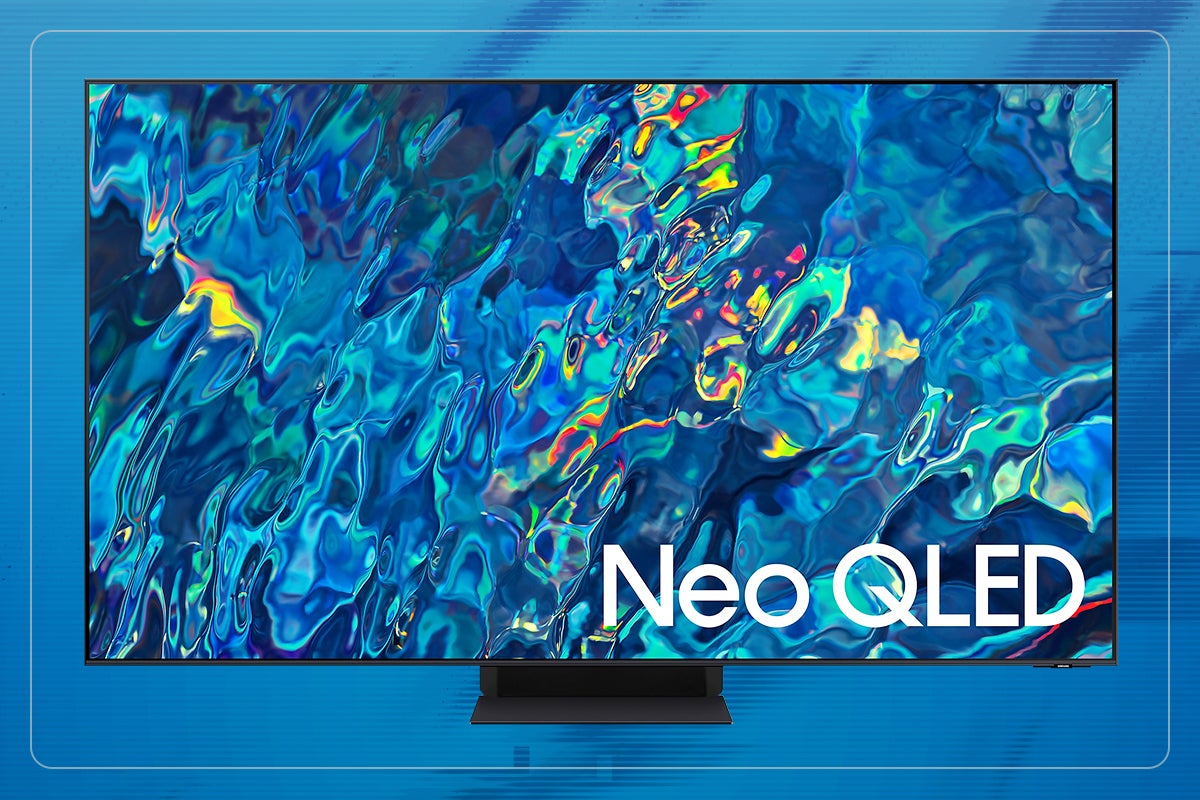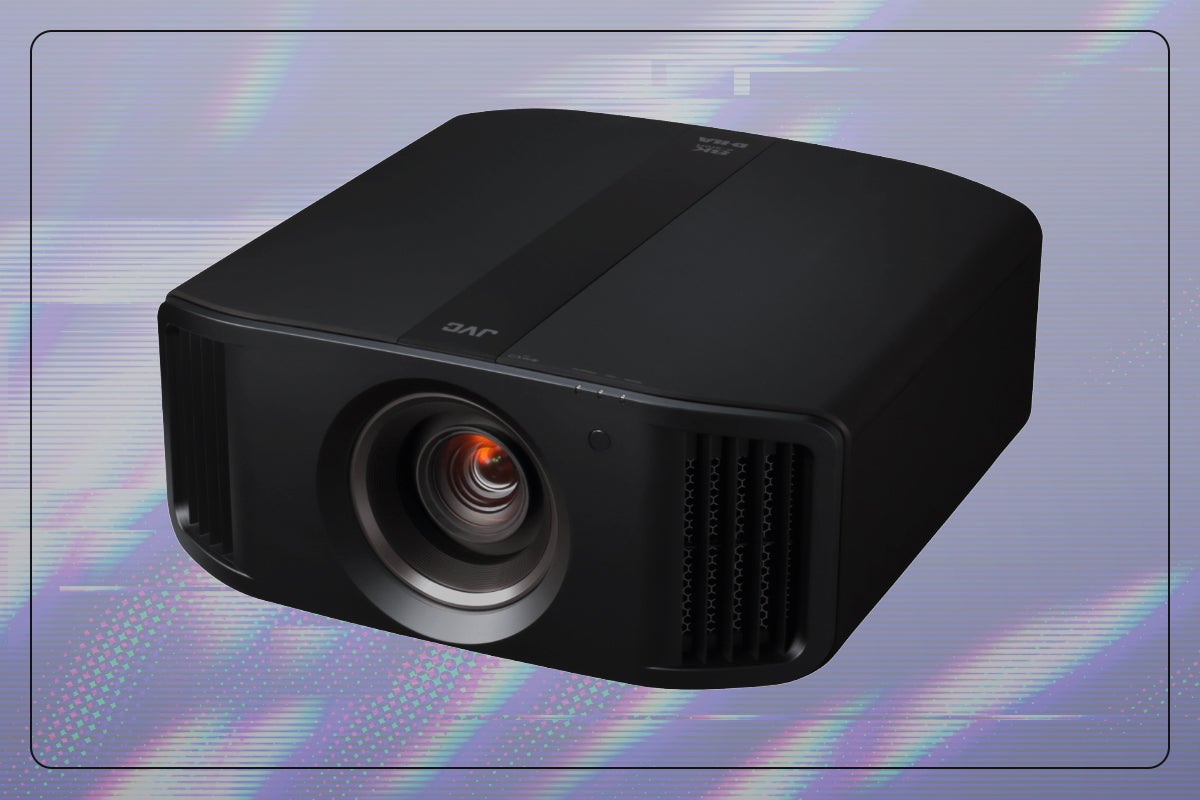Verdict
There are some compromises involved, but if you want a TV-like experience from a large-screen projector, the AWOL Vision LTV-3500 is the brightest laser TV that we’ve reviewed. It produces bright and vibrant images, although blacks could be better, and it is bright enough that it can be used during the day. Although cheaper than an actual 100-inch TV, this projector is expensive and you have to factor in the cost of a ALR screen to get the most out of it.
Pros
- Bright enough to watch during the day
- Loud speakers
- Feels like a TV
Cons
- Expensive and doesn’t include the screen
- Only three HDMI inputs
- Average black levels
-
100-inch 4K pictureUses DLP XPR to boost a 1080p image to 4K. -
Media streamingShips with an Amazon Fire TV Stick 4K Max, which plugs into a compartment on the back of the projector. -
Built-in speakersDual 36W speakers support Dolby Vision and DTS-X.
Introduction
Should I buy a large-screen TV or a projector? This is the age-old question facing those looking for a quality home cinema experience.
Now, we’re getting to the age with Ultra Short Throw projectors (or laser TVs as they like to be called) where the answer can reasonably be both. With a huge 3500-lumens brightness, and able to cast a 100-inch screen from just a few inches, the AWOL Vision LTV-3500 is one of the strongest contenders yet.
At its best, it delivers an awe-inspiring big-screen experience that’s hard to believe it’s coming from a projector. It is expensive, particularly as it doesn’t ship with a screen, and the limited number of HDMI ports may put some off.
Design
- Sits close to the wall
- Best used with an ambient light-rejecting screen
- Speakers built in
As with all Ultra Short Throw projectors, the AWOL Vision LTV-3500 is a wide flat box, designed to sit just in front of the projection surface, beaming its picture upwards. It’s quite a large and chunky box (145 x 595 x 353mm) and at 12.4kg it’s a solid bit of kit.
It sat neatly enough on my standard TV cabinet, although I did have to slide this forward to give the projector the 9.8-inch gap to project a 100-inch image. A slightly deeper cabinet would make more sense with this model to give it a neater installation.
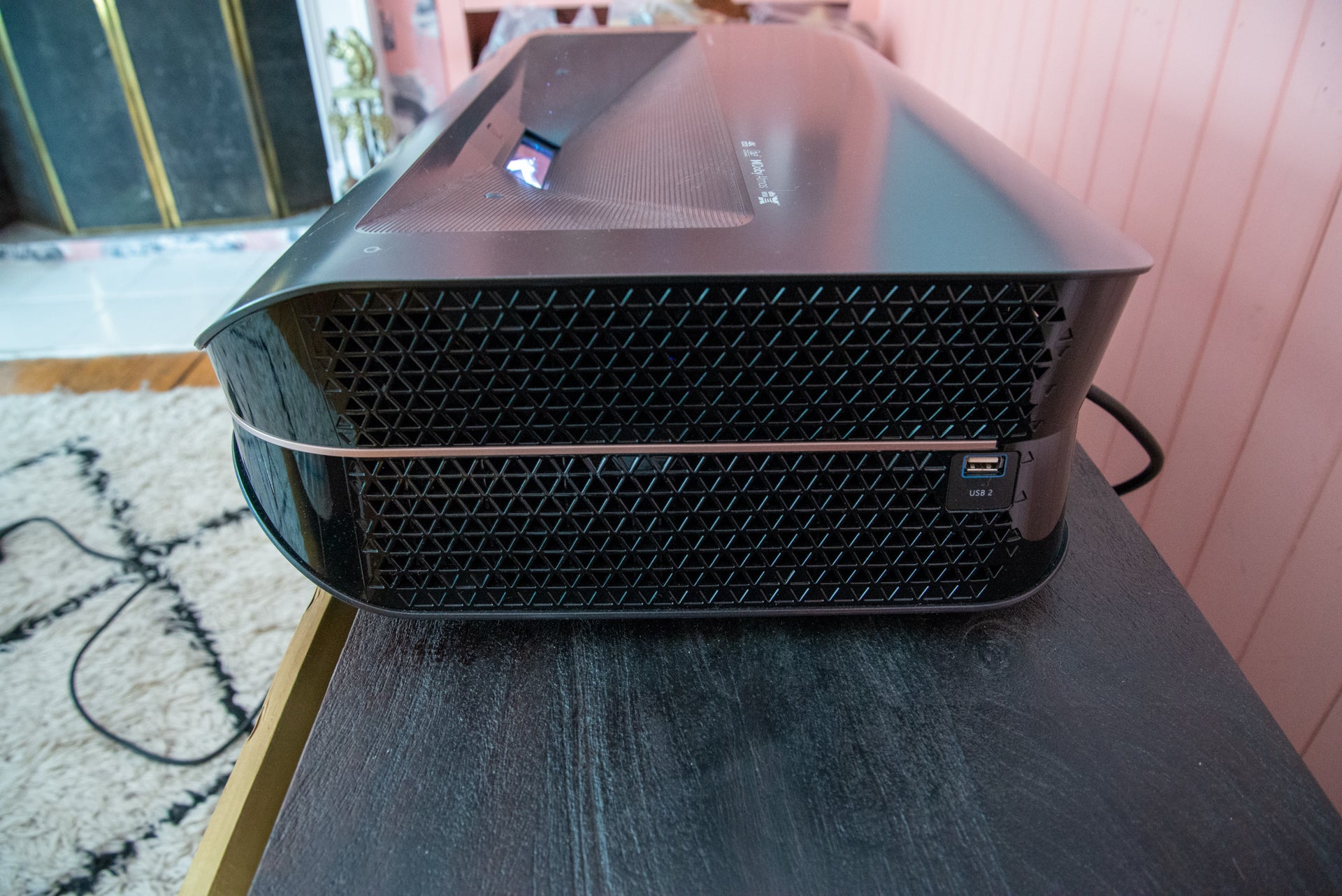
Even so, having a projector so close to a wall means that it can be swapped like-for-like with a TV, without having to buy extra long HDMI cables to reach a projector mounted in the middle of a room.
I was loaned an AWOL Vision Daylight ALR (Ambient Light Rejecting) Screen for testing. This, effectively, only reflects light shone from below it, rejecting other light, making the AWOL Vision LTV-3500 suitable for use during the day. It’s a needed accessory, but it’s also an additional $1399 for the 100-inch model, with the larger 120-inch version costing $2299. You can buy alternative third-party ones.
The rival Hisense 100L9GTUK Laser TV ships with a 100-inch ALR screen, costing less overall. Plus, at the time of review, Hisense was offering to come around and fit the screen and set the projector up for free.
With the AWOL Vision LTV-3500, you have to set up the screen yourself, which involves screwing the frame together, and tensioning it to keep it all flat, so you can get a perfect image. There’s then the job of mounting the screen on the wall, which takes a little adjustment to get everything square and level.
It’s a job worth doing properly, as the finished result looks great – just like having a huge TV on the wall.
Features
- 4K (XPR) image
- Tri-laser ultra short throw projector
- Three HDMI inputs, HDMI eARC output
Although I’ve seen laser TVs before, such as the more value-orientated XGIMI Aura, brightness has been the issue. The XGIMI Aura peaks at 2400 lumens, so needs a dimmed room to work in; here, the AWOL Vision LTV-3500 has a massive 3500-lumens brightness.
As the projector is so close to the screen, less light is lost in transmission than with a regular projector. Combined with the ALR screen, light that isn’t from the projector is rejected, cutting out reflections that will quickly spoil the party. I’ll dig deeper into image quality, but the brightness and screen combined mean that this system can be watched during the day, with curtains open, just like with a normal TV.
Technically, you can project onto a flat wall, but you’ll get worse contrast, a dimmer screen and, unless your walls are really flat, every imperfection highlighted.
Furthering the fact that this is a TV, not a projector, are 36W stereo speakers compatible with Dolby Atmos. Thanks to the size of the case, there’s more room for quality speakers than you’ll get on a regular TV. There’s no tuner on this model, so you’ll need some kind of set-top box if you want to watch broadcast TV.
That’ll eat up one of the HDMI 2.0b inputs. There’s a second port that provides HDMI eARC, so that could well be gone if you decide to hook up a soundbar, such as the Sonos Arc instead of relying on the onboard sound.
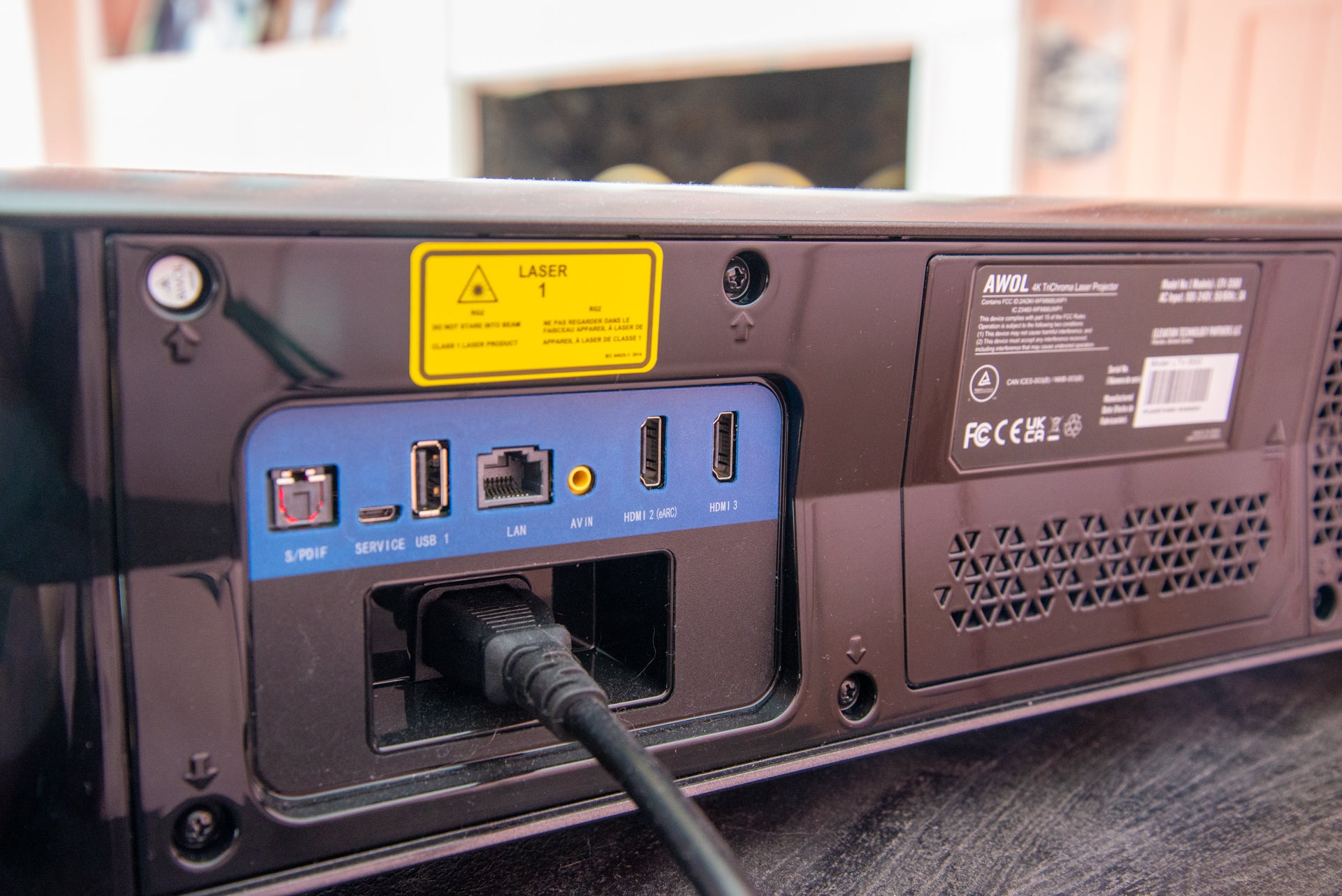
There is a third HDMI 2.0b input, although this one is hidden underneath a panel and is taken up by the bundled Amazon Fire TV Stick 4K Max. On one hand, this is a good shout. Rather than AWOL Vision managing apps and software updates, even though the projector runs Android 9.9, it’s passed this over to Amazon and the brilliantly supported Fire TV Stick.
However, it means that the HDMI inputs can go quickly, and I had no ports free to plug in my 4K Blu-ray player; it’s either a plug-and-unplug job or I’d need to invest in an HDMI switch. Just one more HDMI input would have made things perfect.
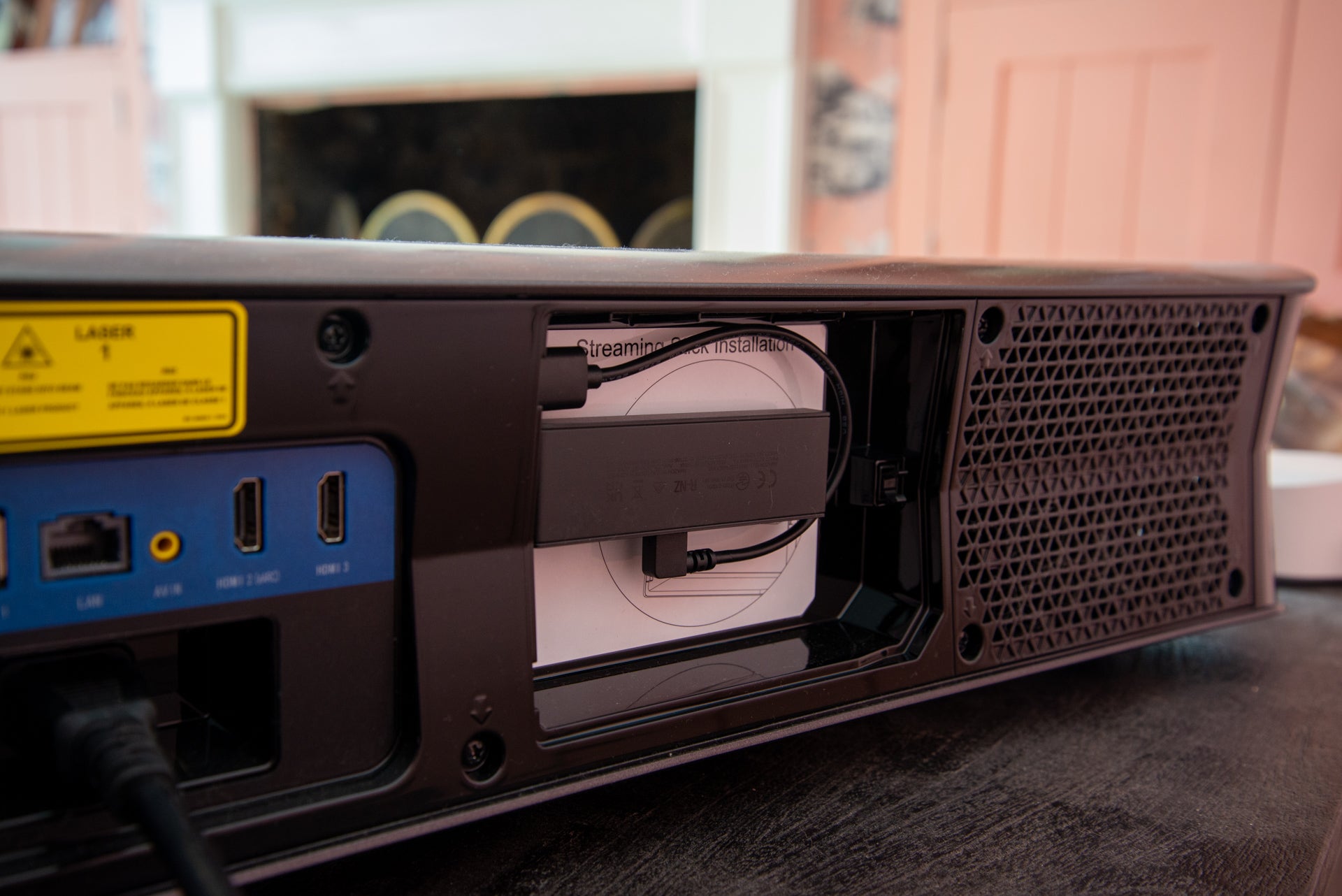
None of the inputs supports 4K/120Hz or variable refresh rate gaming that high-end TVs have. Input lag comes in at around 30ms, so it’s not particularly one for dedicated first-person shooter players, although regular single-player gaming is fun.
Branded as a 4K model, the AWOL Vision LTV-3500, like all other DLP 4K models, uses a technology called XPR combined with a Full HD projector chip. It works by shifting the DLP chip slightly, four times per frame, to scale up the resolution to 4K.
You don’t get true one-to-one 4K pixel mapping, but the technology is advanced enough to fool you into thinking that there’s a 4K image on-screen (or near enough). Compared to a Full HD projector, XPR models, such as the AWOL Vision LTV-3500, look far more detailed.
HDR support is present with both HDR10+ and HLG are both supported, with the former quite rare to see on projectors. There’s no Dolby Vision support, which is rarer still on projectors.
Three lasers (red, green and blue) are used in succession to create a colour image on screen, forgoing the need for a colour wheel, and creating a brighter image with a wider colour gamut: AWOL Vision claims 107% of the HDR Rec 2020 (also known as BT.2020) standard. This is common for laser, DLP projectors and the same claim as made by the Hisense 100L9GTUK.
AWOL Vision says that the non-replaceable lasers will last for 25,000 hours. That’s more than ten years if you were to watch for eight hours a day, longer if you watch TV far less.
I measured power consumption at 200W, which is double that of my 55-inch LG OLED TV, although here I’ve got almost four times the screen size. It’s a fair trade-off if you want a big screen, and the AWOL Vision LTV-3500 isn’t excessively expensive to run.
As with most laser TVs, there are very few configuration options. Getting a square picture relies on aligning the projector properly with the screen, and adjusting its four feet to get it level. There’s basic six-point keystone correction if you can’t quite get the picture to line-up properly, plus a focus control to get the image sharp at different sizes.
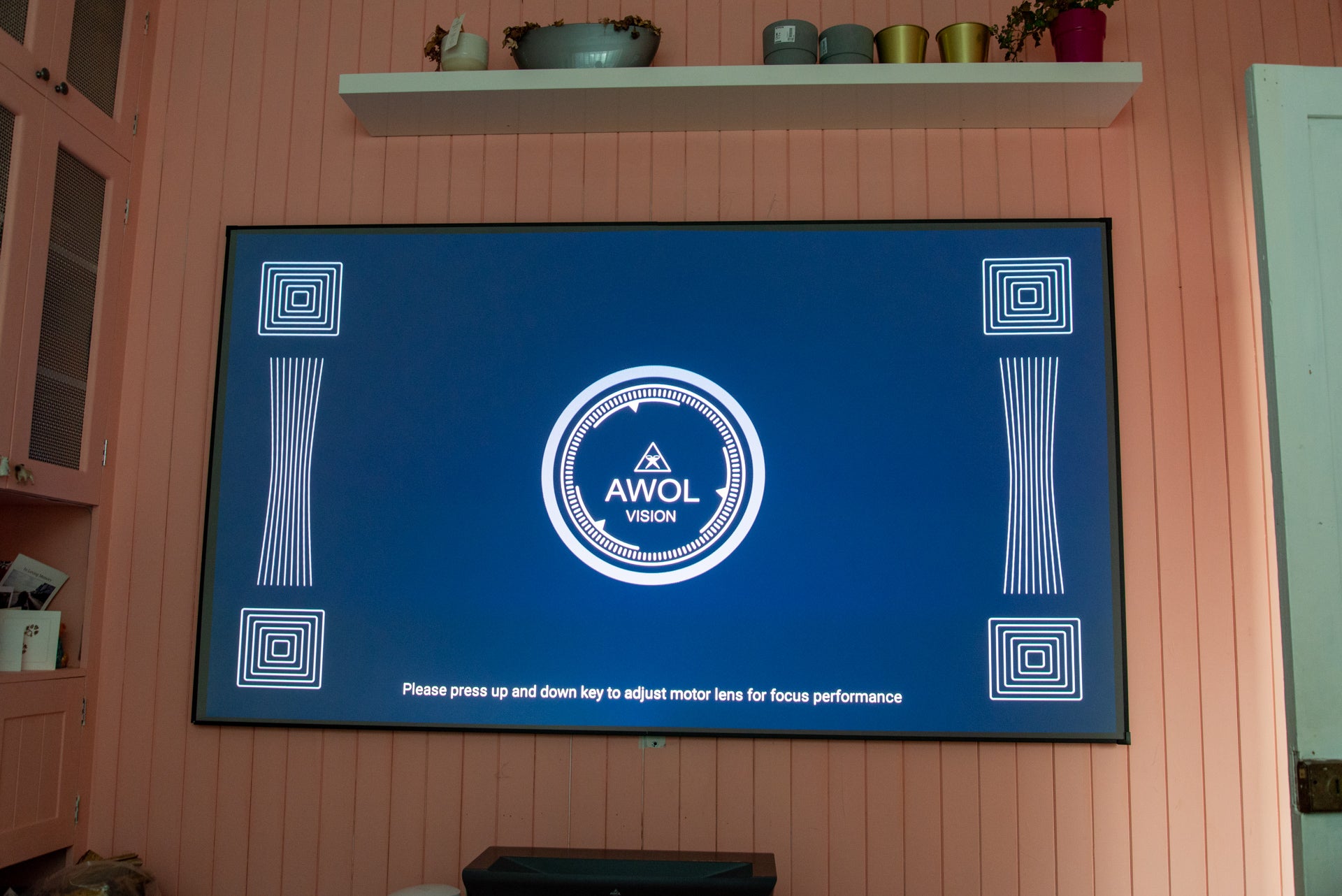
There’s a neat remote control in the box, which I only ever use for changing input, and adjusting settings, so it’s not touched much.
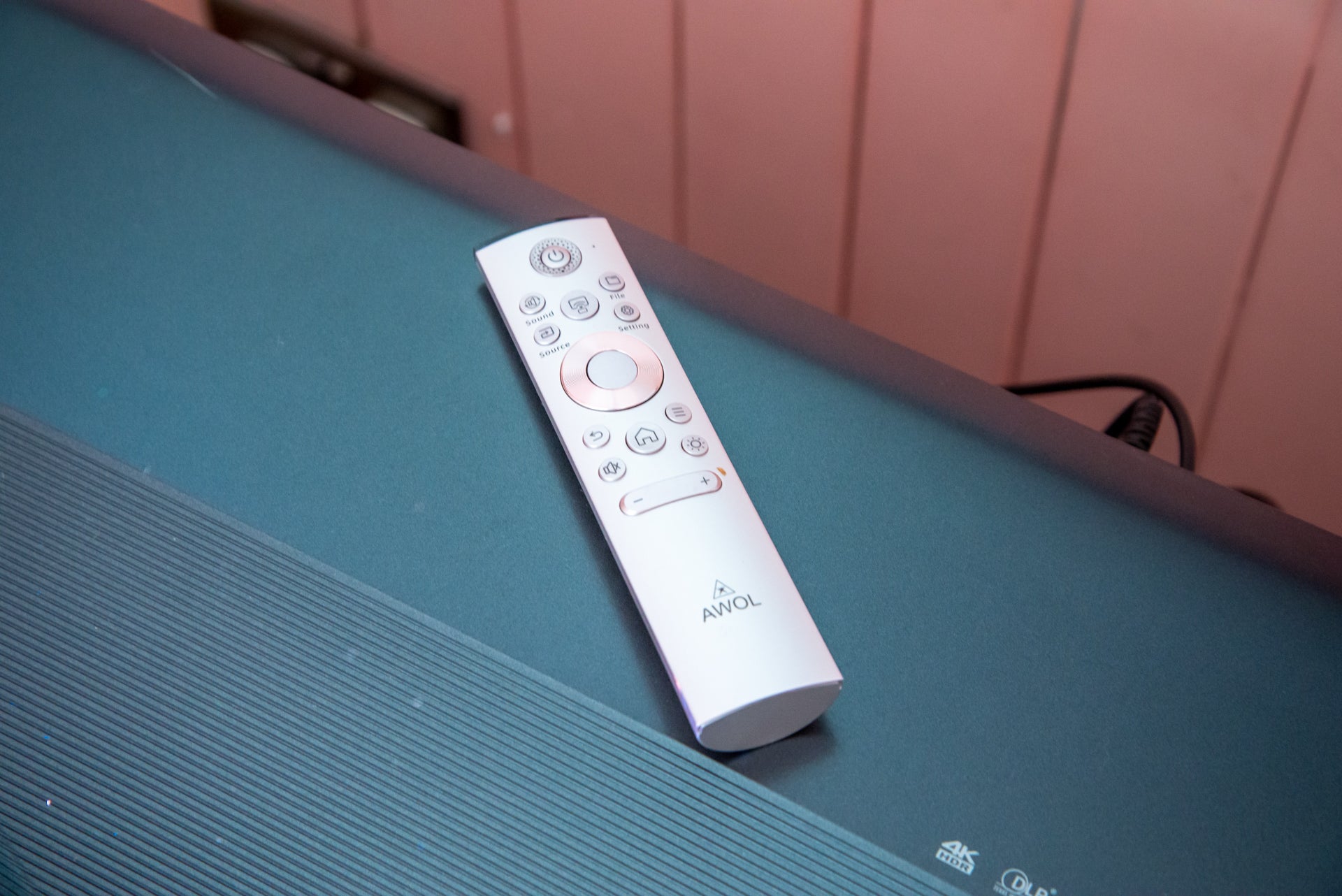
Picture Quality
- Bright and vivid picture
- Blacks not as dark as on a TV
- Sharp image
Firing up the AWOL Vision LTV-3500, I find it hard not to have a smile on my face. Even in a brightly lit room (my lounge windows face south and get the sun all day), the projector can deliver a bright image that can be seen all-day long. It really does look like there’s a massive TV in the room.
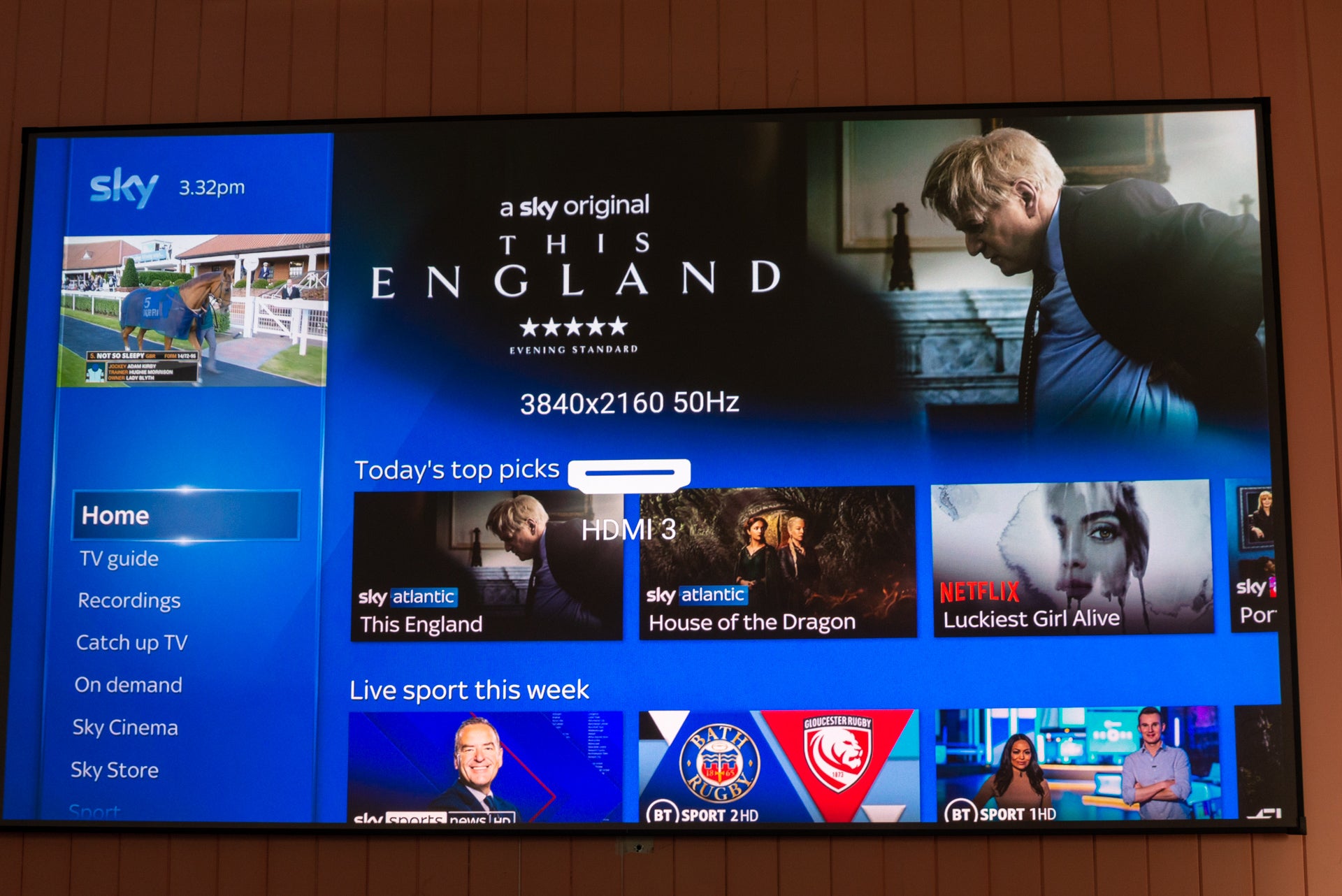
That’s impressive from the start, as the AWOL Vision LTV-3500 really can replace a TV for normal use: there’s no need to go and shut blinds or to try and move the projector closer to the screen to get a proper image.
Of course, there are limits to the system. Some ambient light does get in the way of the picture, and during the day, the AWOL Vision LTV-3500 doesn’t look as intense or its colours as rich as when the curtains are shut and it’s dark in the room. That’s an argument that can be levelled at most display devices, and if you want to watch at the best quality, you want to do so in the dark or near dark.
Watch 4K on a good quality input, and the AWOL Vision LTV-3500 shines. Watching the Lord of the Rings: The Rings of Power on Prime Video, and the Elven kingdom of Lindon pops out the screen: its rich greens and golds, and bright skies are perfect for showing off what the AWOL Vision LTV-3500 is capable of at its best. Detail is high and there’s enough detail to see the intricate details that you’d expect to see on a 4K device.
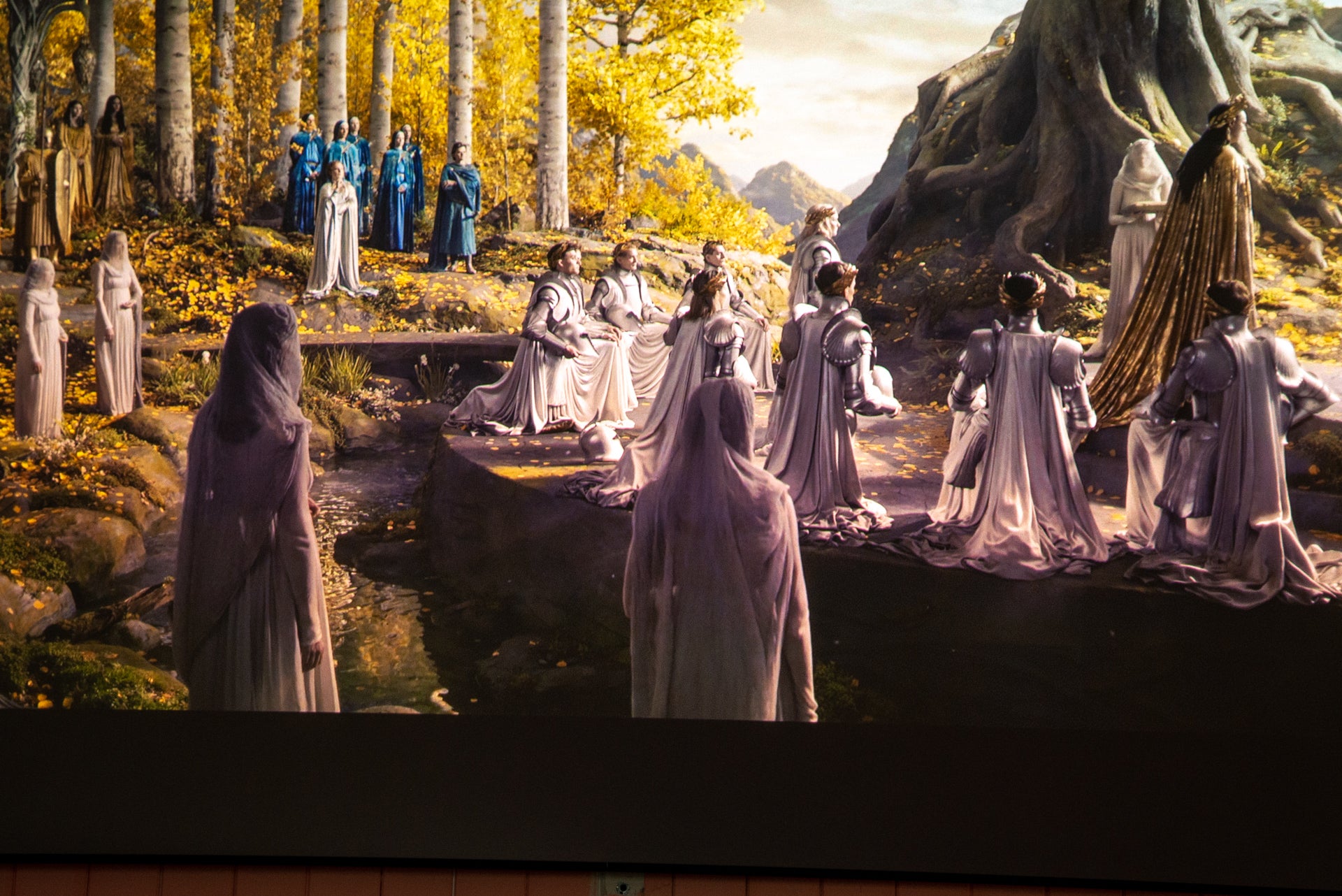
It’s not all plain sailing. Out of the box, I found the projector made flesh tones a little too red, making it look as though a lot of people had fake tan. Dive deep into the menus, and there’s full colour control to adjust this, and I found it worth spending time getting the image quality right.
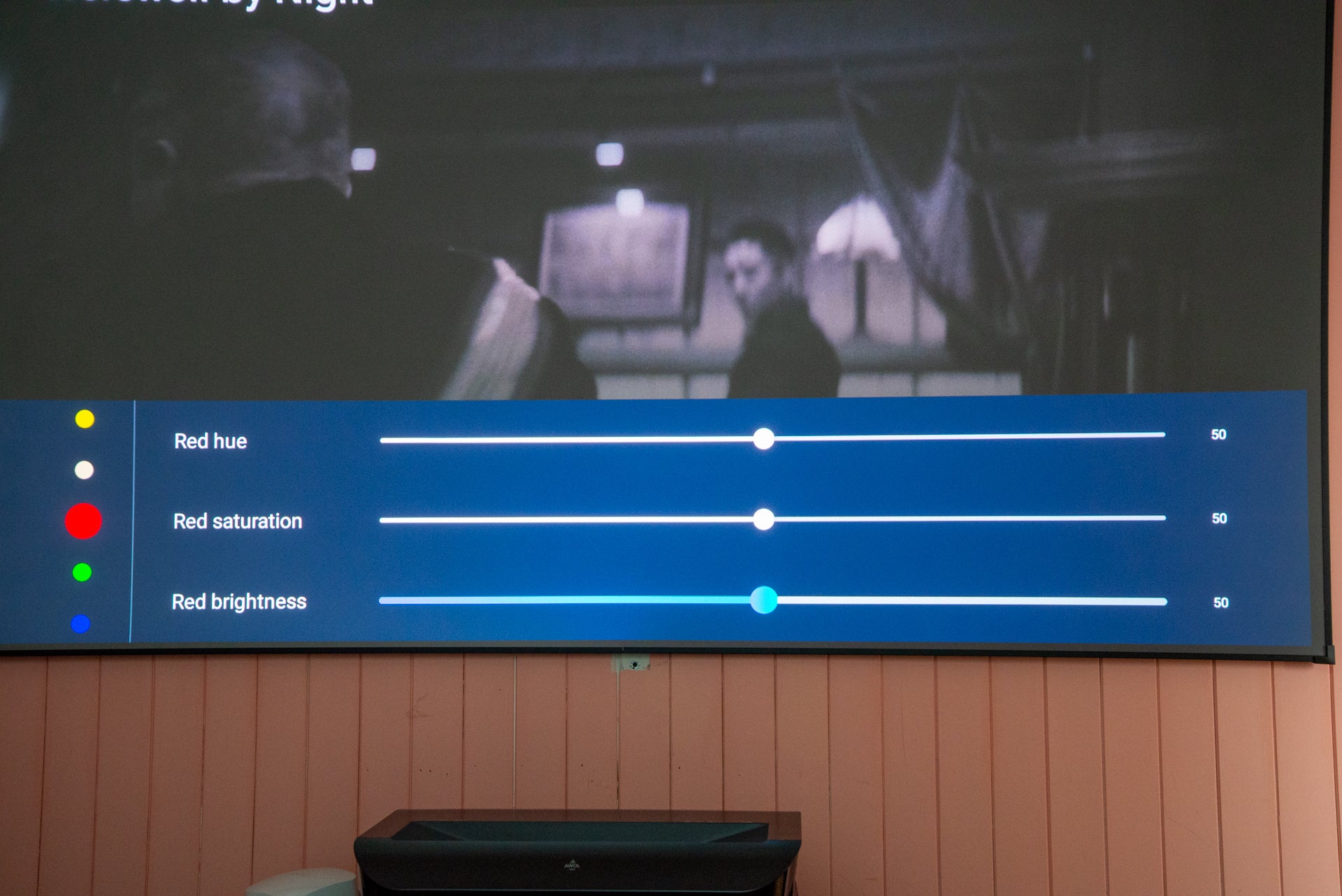
For all of its qualities, the AWOL Vision LTV-3500 doesn’t deliver black-level performance that can compete with the best TVs, particularly OLED models. When I fire up my OLED, there are deep and dark blacks, with detail right into the shadow.
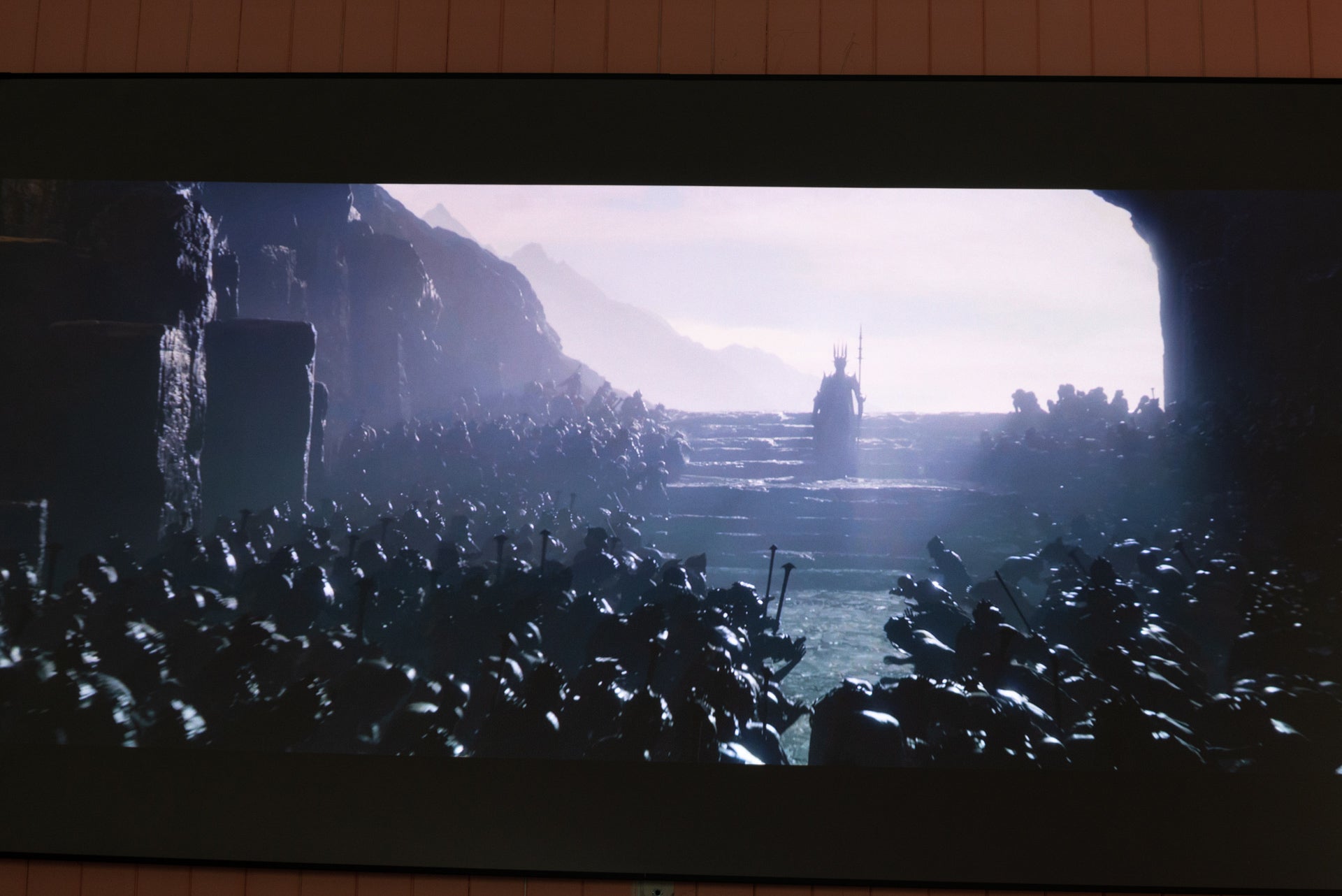
With the AWOL Vision LTV-3500, it gets as black as the screen, which is to say a shade of grey. Some detail is lost in darker scenes. Again, this is more of an issue with projected images than a flaw in the projector as such.
Although the tri-laser colour system cuts down on the DLP rainbow effect, it’s still evident in some scenes. Get a fast moving image, high-contrast scene or quick cut, and there’s the occasional flash of colour. I didn’t find it particularly annoying, but if you’re overly sensitive to the rainbow effect, a DLP projector of any kind probably isn’t for you.
If there’s one issue with XPR, it’s that the screen has to run at 60Hz, with no other refresh rates available. Watch a film at 24p, and it has to be adjusted to fit the 60Hz refresh rate. Likewise, regular TV (25fps in the UK) and it has to be displayed at 60Hz.
For the most part the AWOL Vision LTV-3500 does a good job of handling frame rate mismatches, but I did find I needed to turn on the Motion Estimation Motion Compensation (MEMC) feature, which adds some interrelated frames. Stick this setting on low (or medium if you want) and it smooths out the picture without veering into soap opera technology.
Watch football or rugby (or any other fast-paced sport) and the projector can smoothly keep up with the ball.
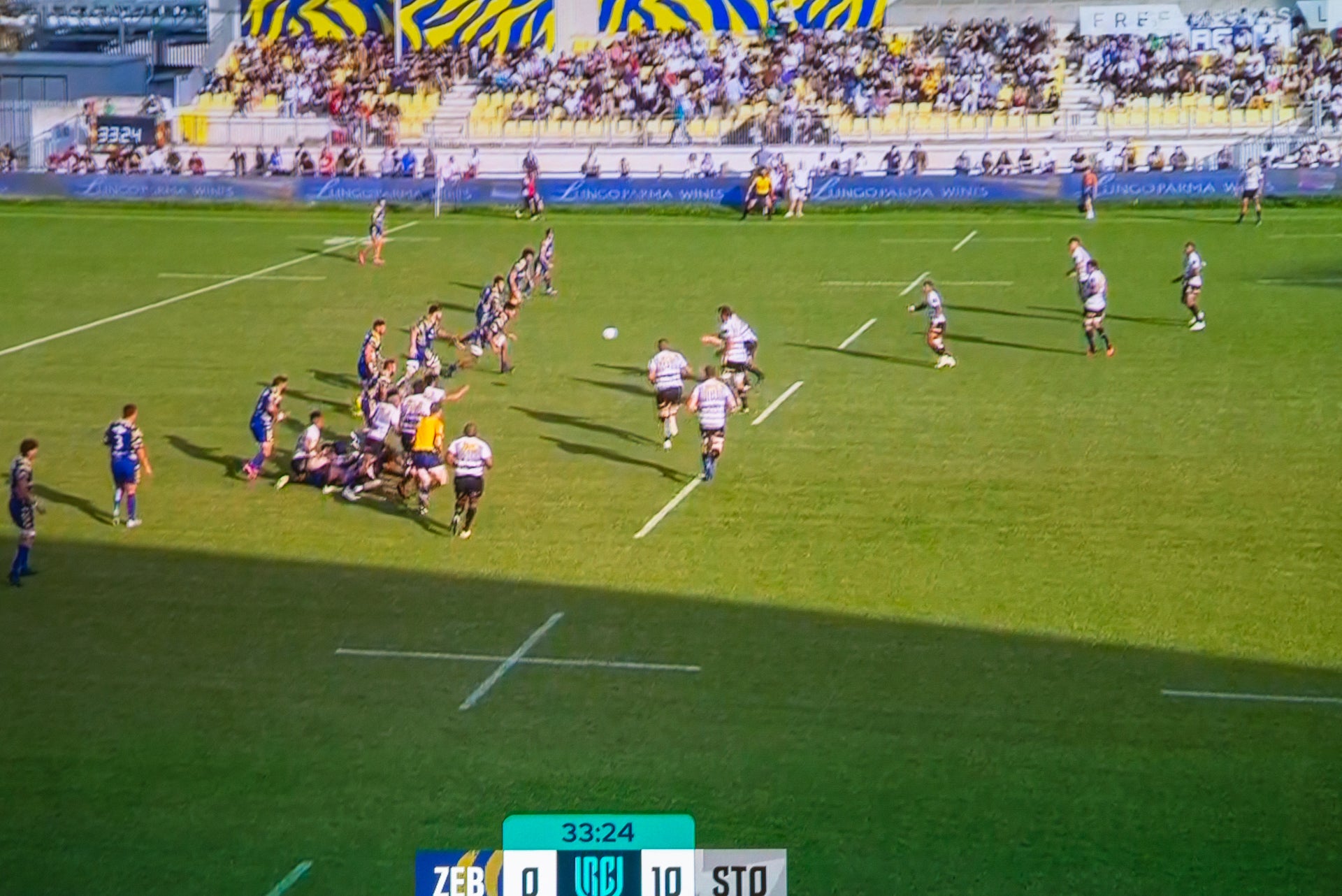
Put lower quality images into the projector, such as standard definition broadcast TV, and the AWOL Vision LTV-3500 does a pretty reasonable job of upscaling it so the result doesn’t look horrible on a 100-inch screen (well, any more horrible than SD content looks generally).
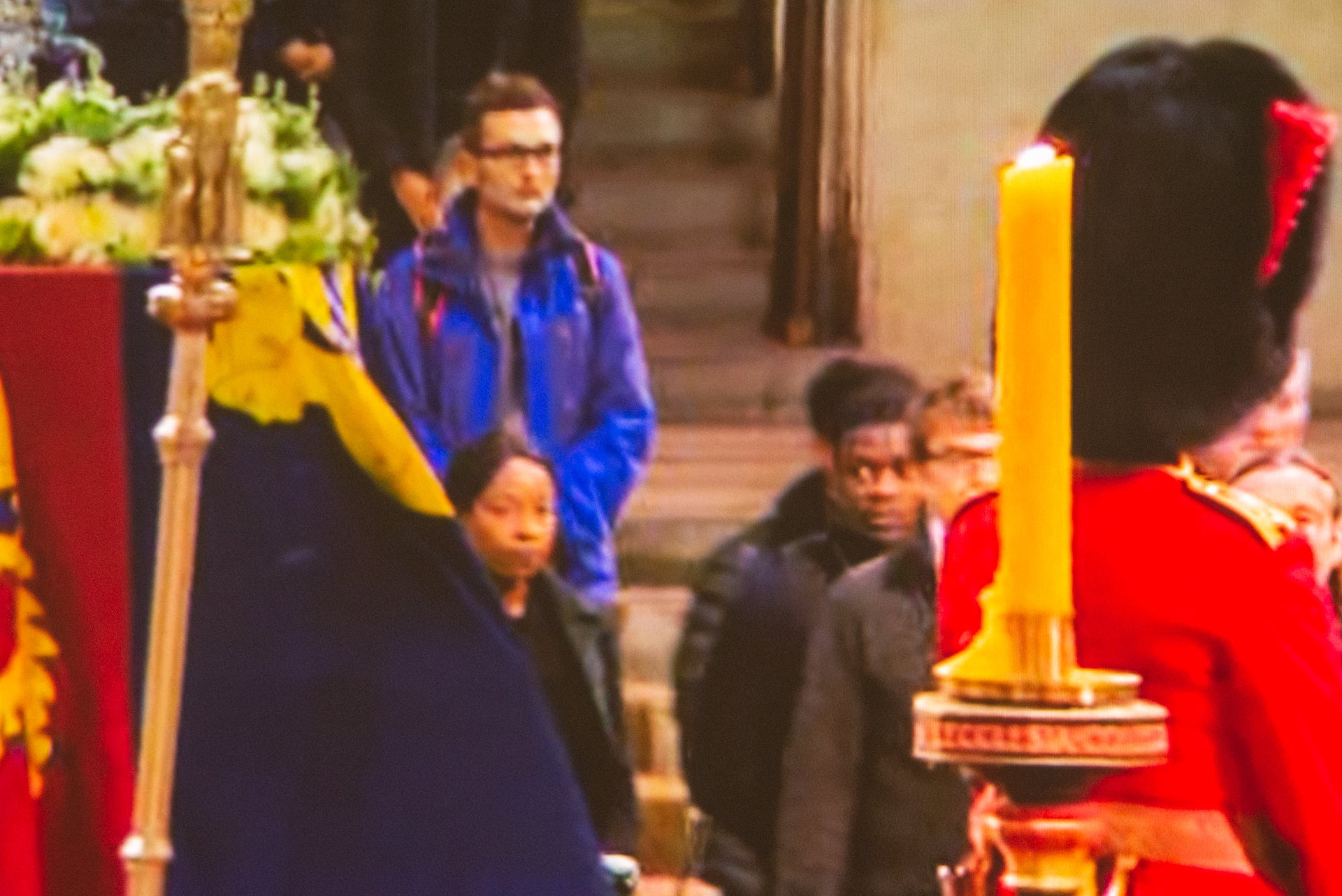
That said, low-quality TV does introduce some artefacts, particularly with fast cuts. Blown up to epic proportions, artefacts like this are far easier to spot than on a smaller TV.
Pure cinema fans will want a projector that can handle filmic frame rates, and something with inkier blacks. However, as a trade-off, this is a great compromise: a projector that can handle TV and do a pretty good job when it comes to films.
One word of warning: it’s worth using the provided cloth to clean the lens often. Get a bit of cat hair or dust on the lens, and the super-bright lights and large image can end up with some funny artefacts on-screen.
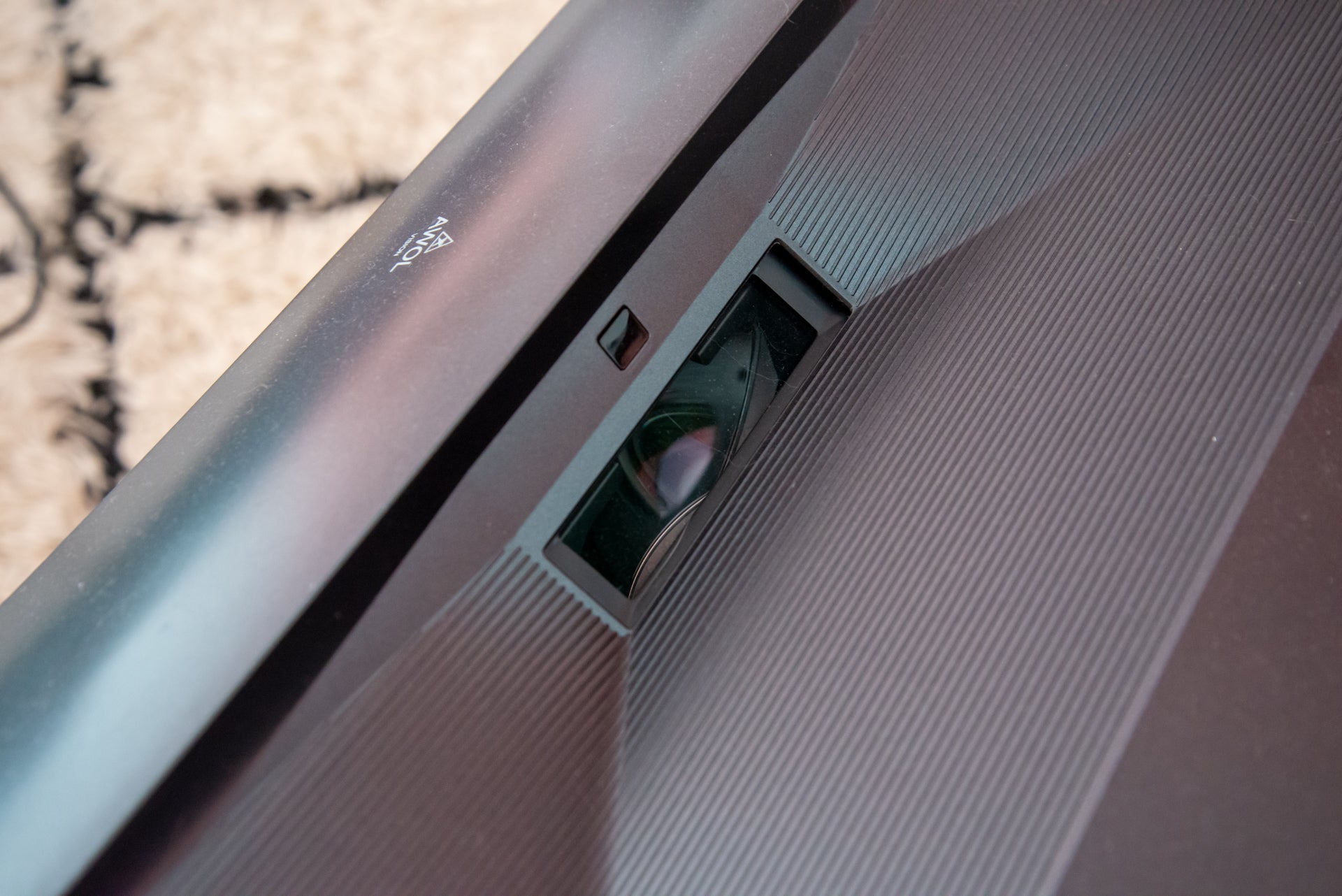
There’s an ambient light setting that can adjust the projector’s brightness automatically, although I didn’t find it that reliable, and it was sometimes too dark in a brightly lit room. To that end, I preferred to set the light mode automatically.
Likewise, I moved between HDR Standard and HDR Vivid depending on the content I was watching.
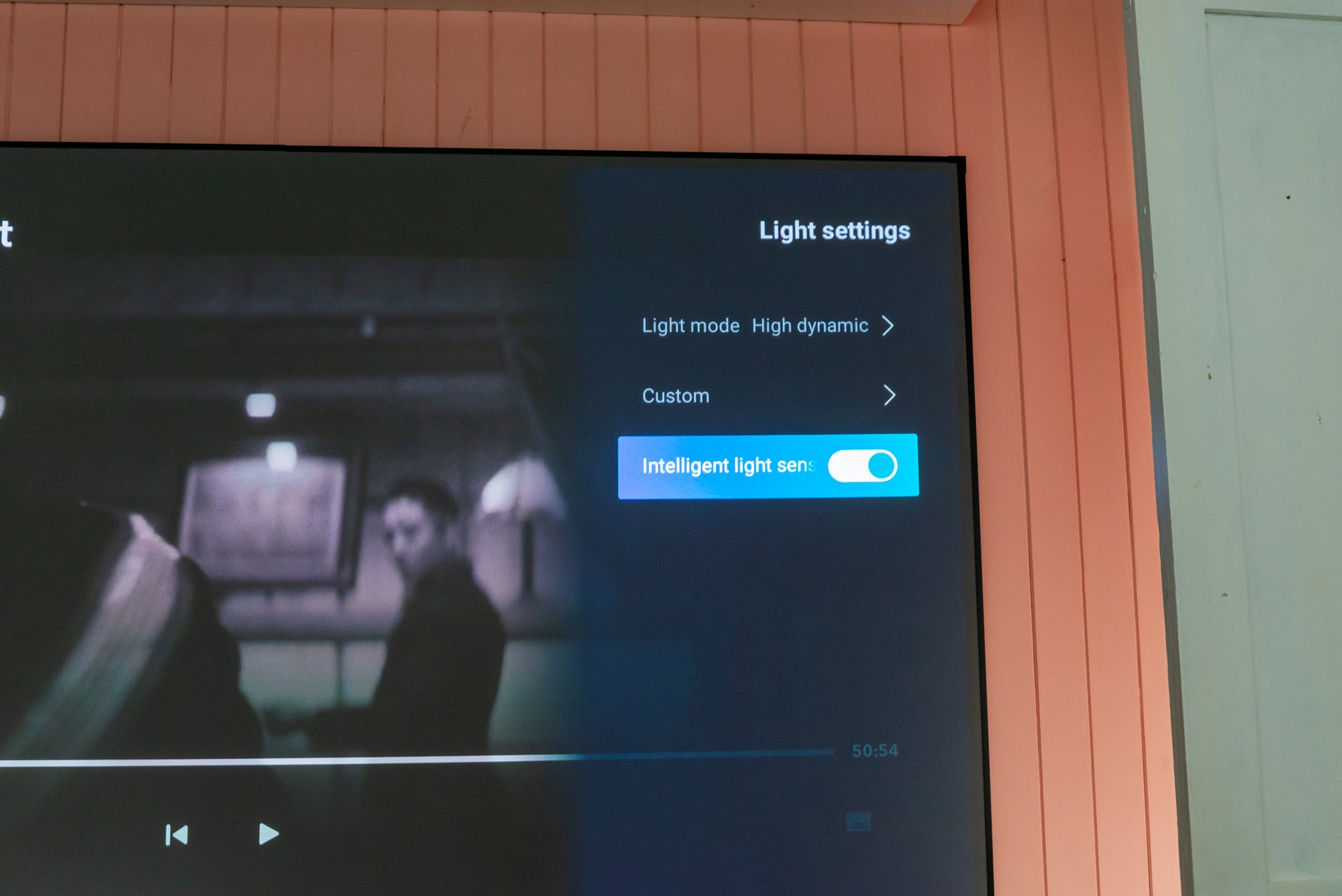
Sound quality
- Little bass
- Dolby Atmos and DTS:X support
- Forward-firing speakers
Dual 36W speakers make the AWOL Vision LTV-3500 sound pretty good for a projector. I’d say that this projector sounds as good as a budget soundbar. Certainly, the audio it produces is loud enough and detailed enough to fill a room.
Dolby Atmos and DTS:X decoding is nice to see from a specs perspective, but the speakers can’t do it justice: audio never really sounded like it was coming from above me, nor could it fake surround channels.
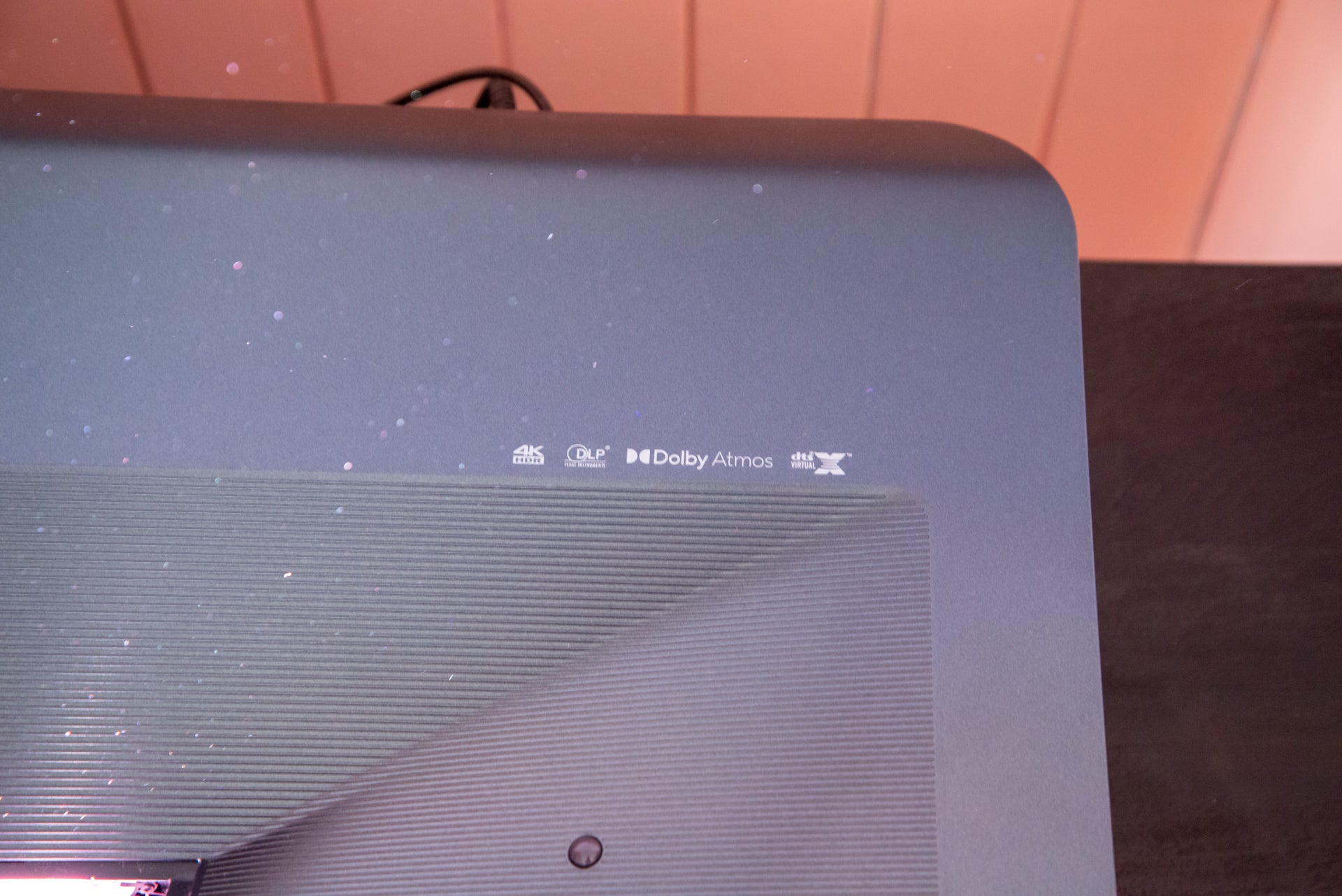
There’s not much bass here, so more demanding soundtracks lose their impact and don’t quite deliver. Don’t get me wrong, the AWOL Vision LTV-3500 sounds far better than any regular TV or projector but it’s not cinematic. I left my Sonos Arc and surround sound speakers connected.
While the projector is on, its fans run and they’re gently audible. When watching something louder and more involved, it’s hard to hear them, but the fans penetrate more gentle soundtracks to a degree. I found that I got used to them and didn’t find the fans too annoying.
Latest deals
Should you buy it?
A TV experience on a huge scale It’s bright enough to cope with daylight (provided you have the ALR screen), sharp and detailed enough to handle films, and is cheaper than a 100-inch TV.
You want a true cinema experience This projector is locked to 60Hz because of its XPR technology, and dark room performance isn’t as good as with the best home cinema projectors.
Final Thoughts
It’s impossible not to be impressed by the AWOL Vision LTV-3500. It gives a true TV experience an a huge screen. After using it for a few weeks, I got used to the 100-inch picture, and it made every other screen in my house seem small; it’s hard to go back to watching a regular TV after this.
It’s a high-quality projector when it comes to films and quality inputs, too, giving a balance between a TV experience and a movie-room experience. The peak brightness of 3500-lumens is a step up from even the Hisense 100L9GTUK, while HDR10+ support boosts HDR image quality. Pixel-for-pixel, this is a better-quality device.
Yet, for all its triumphs, it’s not going to be for everyone: it’s expensive, doesn’t include the ALR screen as standard, and it’s locked at 60Hz. If you want that huge screen experience and can accept this projector’s limitations, it’s a great buy, but you’ll get better image quality and better refresh rate support from a premium TV.
How we test
We test every projector we review thoroughly over an extended period of time. We use industry standard tests to compare features properly. We’ll always tell you what we find. We never, ever, accept money to review a product.
Find out more about how we test in our ethics policy.
Test for more than a week
Tested with real world use
FAQs
Brightness is the main difference, with the LTV-3500 rated at 3500-lumen, and the LTV-2500 at 2500 lumen.
Yes, it’s bright enough to produce an image in daylight, but avoid direct sunlight and buy the ambient light-rejecting screen for the best results.W
Streaming is provided via the bundled Amazon Fire TV Stick 4K Max, so all major streaming services are accounted for.
Verdict
There are some compromises involved, but if you want a TV-like experience from a large-screen projector, the AWOL Vision LTV-3500 is the brightest laser TV that we’ve reviewed. It produces bright and vibrant images, although blacks could be better, and it is bright enough that it can be used during the day. Although cheaper than an actual 100-inch TV, this projector is expensive and you have to factor in the cost of a ALR screen to get the most out of it.
Pros
- Bright enough to watch during the day
- Loud speakers
- Feels like a TV
Cons
- Expensive and doesn’t include the screen
- Only three HDMI inputs
- Average black levels
-
100-inch 4K pictureUses DLP XPR to boost a 1080p image to 4K. -
Media streamingShips with an Amazon Fire TV Stick 4K Max, which plugs into a compartment on the back of the projector. -
Built-in speakersDual 36W speakers support Dolby Vision and DTS-X.
Introduction
Should I buy a large-screen TV or a projector? This is the age-old question facing those looking for a quality home cinema experience.
Now, we’re getting to the age with Ultra Short Throw projectors (or laser TVs as they like to be called) where the answer can reasonably be both. With a huge 3500-lumens brightness, and able to cast a 100-inch screen from just a few inches, the AWOL Vision LTV-3500 is one of the strongest contenders yet.
At its best, it delivers an awe-inspiring big-screen experience that’s hard to believe it’s coming from a projector. It is expensive, particularly as it doesn’t ship with a screen, and the limited number of HDMI ports may put some off.
Design
- Sits close to the wall
- Best used with an ambient light-rejecting screen
- Speakers built in
As with all Ultra Short Throw projectors, the AWOL Vision LTV-3500 is a wide flat box, designed to sit just in front of the projection surface, beaming its picture upwards. It’s quite a large and chunky box (145 x 595 x 353mm) and at 12.4kg it’s a solid bit of kit.
It sat neatly enough on my standard TV cabinet, although I did have to slide this forward to give the projector the 9.8-inch gap to project a 100-inch image. A slightly deeper cabinet would make more sense with this model to give it a neater installation.

Even so, having a projector so close to a wall means that it can be swapped like-for-like with a TV, without having to buy extra long HDMI cables to reach a projector mounted in the middle of a room.
I was loaned an AWOL Vision Daylight ALR (Ambient Light Rejecting) Screen for testing. This, effectively, only reflects light shone from below it, rejecting other light, making the AWOL Vision LTV-3500 suitable for use during the day. It’s a needed accessory, but it’s also an additional $1399 for the 100-inch model, with the larger 120-inch version costing $2299. You can buy alternative third-party ones.
The rival Hisense 100L9GTUK Laser TV ships with a 100-inch ALR screen, costing less overall. Plus, at the time of review, Hisense was offering to come around and fit the screen and set the projector up for free.
With the AWOL Vision LTV-3500, you have to set up the screen yourself, which involves screwing the frame together, and tensioning it to keep it all flat, so you can get a perfect image. There’s then the job of mounting the screen on the wall, which takes a little adjustment to get everything square and level.
It’s a job worth doing properly, as the finished result looks great – just like having a huge TV on the wall.
Features
- 4K (XPR) image
- Tri-laser ultra short throw projector
- Three HDMI inputs, HDMI eARC output
Although I’ve seen laser TVs before, such as the more value-orientated XGIMI Aura, brightness has been the issue. The XGIMI Aura peaks at 2400 lumens, so needs a dimmed room to work in; here, the AWOL Vision LTV-3500 has a massive 3500-lumens brightness.
As the projector is so close to the screen, less light is lost in transmission than with a regular projector. Combined with the ALR screen, light that isn’t from the projector is rejected, cutting out reflections that will quickly spoil the party. I’ll dig deeper into image quality, but the brightness and screen combined mean that this system can be watched during the day, with curtains open, just like with a normal TV.
Technically, you can project onto a flat wall, but you’ll get worse contrast, a dimmer screen and, unless your walls are really flat, every imperfection highlighted.
Furthering the fact that this is a TV, not a projector, are 36W stereo speakers compatible with Dolby Atmos. Thanks to the size of the case, there’s more room for quality speakers than you’ll get on a regular TV. There’s no tuner on this model, so you’ll need some kind of set-top box if you want to watch broadcast TV.
That’ll eat up one of the HDMI 2.0b inputs. There’s a second port that provides HDMI eARC, so that could well be gone if you decide to hook up a soundbar, such as the Sonos Arc instead of relying on the onboard sound.

There is a third HDMI 2.0b input, although this one is hidden underneath a panel and is taken up by the bundled Amazon Fire TV Stick 4K Max. On one hand, this is a good shout. Rather than AWOL Vision managing apps and software updates, even though the projector runs Android 9.9, it’s passed this over to Amazon and the brilliantly supported Fire TV Stick.
However, it means that the HDMI inputs can go quickly, and I had no ports free to plug in my 4K Blu-ray player; it’s either a plug-and-unplug job or I’d need to invest in an HDMI switch. Just one more HDMI input would have made things perfect.

None of the inputs supports 4K/120Hz or variable refresh rate gaming that high-end TVs have. Input lag comes in at around 30ms, so it’s not particularly one for dedicated first-person shooter players, although regular single-player gaming is fun.
Branded as a 4K model, the AWOL Vision LTV-3500, like all other DLP 4K models, uses a technology called XPR combined with a Full HD projector chip. It works by shifting the DLP chip slightly, four times per frame, to scale up the resolution to 4K.
You don’t get true one-to-one 4K pixel mapping, but the technology is advanced enough to fool you into thinking that there’s a 4K image on-screen (or near enough). Compared to a Full HD projector, XPR models, such as the AWOL Vision LTV-3500, look far more detailed.
HDR support is present with both HDR10+ and HLG are both supported, with the former quite rare to see on projectors. There’s no Dolby Vision support, which is rarer still on projectors.
Three lasers (red, green and blue) are used in succession to create a colour image on screen, forgoing the need for a colour wheel, and creating a brighter image with a wider colour gamut: AWOL Vision claims 107% of the HDR Rec 2020 (also known as BT.2020) standard. This is common for laser, DLP projectors and the same claim as made by the Hisense 100L9GTUK.
AWOL Vision says that the non-replaceable lasers will last for 25,000 hours. That’s more than ten years if you were to watch for eight hours a day, longer if you watch TV far less.
I measured power consumption at 200W, which is double that of my 55-inch LG OLED TV, although here I’ve got almost four times the screen size. It’s a fair trade-off if you want a big screen, and the AWOL Vision LTV-3500 isn’t excessively expensive to run.
As with most laser TVs, there are very few configuration options. Getting a square picture relies on aligning the projector properly with the screen, and adjusting its four feet to get it level. There’s basic six-point keystone correction if you can’t quite get the picture to line-up properly, plus a focus control to get the image sharp at different sizes.

There’s a neat remote control in the box, which I only ever use for changing input, and adjusting settings, so it’s not touched much.

Picture Quality
- Bright and vivid picture
- Blacks not as dark as on a TV
- Sharp image
Firing up the AWOL Vision LTV-3500, I find it hard not to have a smile on my face. Even in a brightly lit room (my lounge windows face south and get the sun all day), the projector can deliver a bright image that can be seen all-day long. It really does look like there’s a massive TV in the room.

That’s impressive from the start, as the AWOL Vision LTV-3500 really can replace a TV for normal use: there’s no need to go and shut blinds or to try and move the projector closer to the screen to get a proper image.
Of course, there are limits to the system. Some ambient light does get in the way of the picture, and during the day, the AWOL Vision LTV-3500 doesn’t look as intense or its colours as rich as when the curtains are shut and it’s dark in the room. That’s an argument that can be levelled at most display devices, and if you want to watch at the best quality, you want to do so in the dark or near dark.
Watch 4K on a good quality input, and the AWOL Vision LTV-3500 shines. Watching the Lord of the Rings: The Rings of Power on Prime Video, and the Elven kingdom of Lindon pops out the screen: its rich greens and golds, and bright skies are perfect for showing off what the AWOL Vision LTV-3500 is capable of at its best. Detail is high and there’s enough detail to see the intricate details that you’d expect to see on a 4K device.

It’s not all plain sailing. Out of the box, I found the projector made flesh tones a little too red, making it look as though a lot of people had fake tan. Dive deep into the menus, and there’s full colour control to adjust this, and I found it worth spending time getting the image quality right.

For all of its qualities, the AWOL Vision LTV-3500 doesn’t deliver black-level performance that can compete with the best TVs, particularly OLED models. When I fire up my OLED, there are deep and dark blacks, with detail right into the shadow.

With the AWOL Vision LTV-3500, it gets as black as the screen, which is to say a shade of grey. Some detail is lost in darker scenes. Again, this is more of an issue with projected images than a flaw in the projector as such.
Although the tri-laser colour system cuts down on the DLP rainbow effect, it’s still evident in some scenes. Get a fast moving image, high-contrast scene or quick cut, and there’s the occasional flash of colour. I didn’t find it particularly annoying, but if you’re overly sensitive to the rainbow effect, a DLP projector of any kind probably isn’t for you.
If there’s one issue with XPR, it’s that the screen has to run at 60Hz, with no other refresh rates available. Watch a film at 24p, and it has to be adjusted to fit the 60Hz refresh rate. Likewise, regular TV (25fps in the UK) and it has to be displayed at 60Hz.
For the most part the AWOL Vision LTV-3500 does a good job of handling frame rate mismatches, but I did find I needed to turn on the Motion Estimation Motion Compensation (MEMC) feature, which adds some interrelated frames. Stick this setting on low (or medium if you want) and it smooths out the picture without veering into soap opera technology.
Watch football or rugby (or any other fast-paced sport) and the projector can smoothly keep up with the ball.

Put lower quality images into the projector, such as standard definition broadcast TV, and the AWOL Vision LTV-3500 does a pretty reasonable job of upscaling it so the result doesn’t look horrible on a 100-inch screen (well, any more horrible than SD content looks generally).

That said, low-quality TV does introduce some artefacts, particularly with fast cuts. Blown up to epic proportions, artefacts like this are far easier to spot than on a smaller TV.
Pure cinema fans will want a projector that can handle filmic frame rates, and something with inkier blacks. However, as a trade-off, this is a great compromise: a projector that can handle TV and do a pretty good job when it comes to films.
One word of warning: it’s worth using the provided cloth to clean the lens often. Get a bit of cat hair or dust on the lens, and the super-bright lights and large image can end up with some funny artefacts on-screen.

There’s an ambient light setting that can adjust the projector’s brightness automatically, although I didn’t find it that reliable, and it was sometimes too dark in a brightly lit room. To that end, I preferred to set the light mode automatically.
Likewise, I moved between HDR Standard and HDR Vivid depending on the content I was watching.

Sound quality
- Little bass
- Dolby Atmos and DTS:X support
- Forward-firing speakers
Dual 36W speakers make the AWOL Vision LTV-3500 sound pretty good for a projector. I’d say that this projector sounds as good as a budget soundbar. Certainly, the audio it produces is loud enough and detailed enough to fill a room.
Dolby Atmos and DTS:X decoding is nice to see from a specs perspective, but the speakers can’t do it justice: audio never really sounded like it was coming from above me, nor could it fake surround channels.

There’s not much bass here, so more demanding soundtracks lose their impact and don’t quite deliver. Don’t get me wrong, the AWOL Vision LTV-3500 sounds far better than any regular TV or projector but it’s not cinematic. I left my Sonos Arc and surround sound speakers connected.
While the projector is on, its fans run and they’re gently audible. When watching something louder and more involved, it’s hard to hear them, but the fans penetrate more gentle soundtracks to a degree. I found that I got used to them and didn’t find the fans too annoying.
Latest deals
Should you buy it?
A TV experience on a huge scale It’s bright enough to cope with daylight (provided you have the ALR screen), sharp and detailed enough to handle films, and is cheaper than a 100-inch TV.
You want a true cinema experience This projector is locked to 60Hz because of its XPR technology, and dark room performance isn’t as good as with the best home cinema projectors.
Final Thoughts
It’s impossible not to be impressed by the AWOL Vision LTV-3500. It gives a true TV experience an a huge screen. After using it for a few weeks, I got used to the 100-inch picture, and it made every other screen in my house seem small; it’s hard to go back to watching a regular TV after this.
It’s a high-quality projector when it comes to films and quality inputs, too, giving a balance between a TV experience and a movie-room experience. The peak brightness of 3500-lumens is a step up from even the Hisense 100L9GTUK, while HDR10+ support boosts HDR image quality. Pixel-for-pixel, this is a better-quality device.
Yet, for all its triumphs, it’s not going to be for everyone: it’s expensive, doesn’t include the ALR screen as standard, and it’s locked at 60Hz. If you want that huge screen experience and can accept this projector’s limitations, it’s a great buy, but you’ll get better image quality and better refresh rate support from a premium TV.
How we test
We test every projector we review thoroughly over an extended period of time. We use industry standard tests to compare features properly. We’ll always tell you what we find. We never, ever, accept money to review a product.
Find out more about how we test in our ethics policy.
Test for more than a week
Tested with real world use
FAQs
Brightness is the main difference, with the LTV-3500 rated at 3500-lumen, and the LTV-2500 at 2500 lumen.
Yes, it’s bright enough to produce an image in daylight, but avoid direct sunlight and buy the ambient light-rejecting screen for the best results.W
Streaming is provided via the bundled Amazon Fire TV Stick 4K Max, so all major streaming services are accounted for.



















